Day 1 of a three day long weekend of Late Winter Birding tours today, and we made our way down to the Norfolk Broads. It was forecast to be mostly cloudy with some brighter intervals, but it turned out to be bright and sunny for most of the day, an unexpected bonus.
Our first stop was at Hickling Broad. The walk down the track was rather quiet at first. Out on the marshes, we could see a Little Egret on a pool. A line of Eurasian Teal were asleep round the edge, while some noisy Mallard came out of the rushes nearby. We had a quick look in on Bittern Hide, but there was not much to see from here today so we didn’t linger.
Back on the track, we could hear a Marsh Harrier calling high overhead. Scanning the sky, we eventually spotted one, and then another. The more we looked, the more we managed to find, there were soon Marsh Harriers everywhere. A young bird, still overall dark brown apart from a paler head, flew past lower down. Even better, a smart pale male was displaying to a nearby female way up in the sky, ‘skydancing’ – tumbling and rolling, gradually losing height. It was great to watch.
 Marsh Harrier – some were displaying, ‘skydancing’, today
Marsh Harrier – some were displaying, ‘skydancing’, today
We made our way round on the bank beside the Broad, with the sound of Marsh Harriers calling overhead accompanying us all the way. By the observation tower, we heard a deep sound like a foghorn from the reeds and stopped for a listen. A Bittern was booming nearby, but from deep in the reedbed. Unfortunately it didn’t fly up for us to see, but it was great to hear, the first we have heard this year. With Marsh Harriers displaying and Bittern booming, spring was most definitely in the air at Hickling this morning!
Hickling Broad itself looked rather empty. We did stop for a quick look, which revealed a Great Crested Grebe and a distant raft of Tufted Duck, plus a few Mute Swans and Cormorants. As we walked through the trees, we could hear a Green Woodpecker yaffling and several Jays scolding calls in the wood. A Water Rail squealed from the rushes.
We were almost back to the car park when we stopped to listen to a Reed Bunting singing in a small sapling in the reeds. Back a short distance along the path, the way we had come, several Bearded Tits started calling. We walked back and could hear them either side of the path. A male hopped up briefly into the base of a small birch tree, but dropped down again quickly before zooming across the path in front of us and disappearing into the reeds the other side.
Hickling Broad can be a good place to see Cranes and we had hoped we might at least see some flying over or hear them calling today, but it was not to be. So we decided to drive round via some other good Crane sites to see if we could find any there. The first couple of places we tried drew a blank but at the next stop, we spotted a pair of Cranes distantly out on the marshes. We got out and got them in the scope.
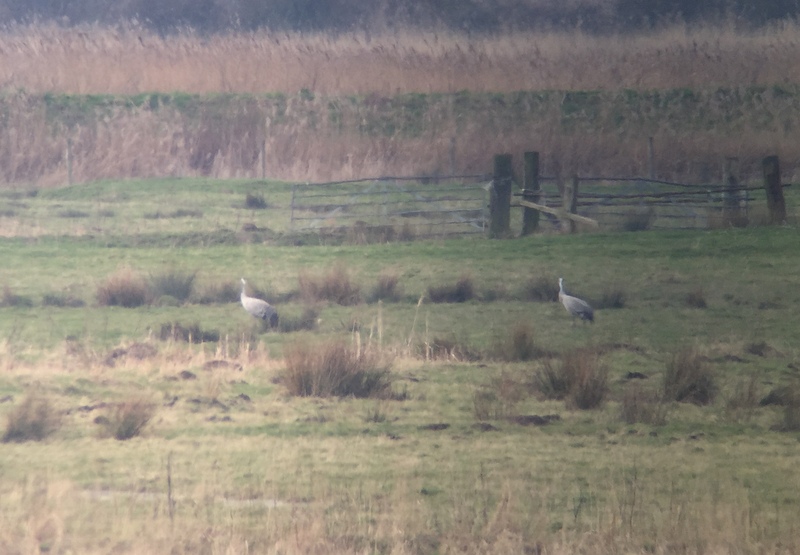 Common Crane – a pair out on the marshes
Common Crane – a pair out on the marshes
For such enormous birds, Cranes can be remarkably hard to find. But while we were watching the first pair, we noticed two more Cranes walk out from behind a strawstack. They were quite a bit closer, but we didn’t have a good angle on them from here, so we drove a little further down the road and stopped again.
The second pair of Cranes had now stopped and were preening out in a rough field. As if that wasn’t enough, we looked back towards the first pair and from here we could see a third pair of Cranes walking straight towards them. They had their bustles fluffed up and looked like they might be calling. The first pair quickly got the message and flew off out of sight, but the third pair then set off after them, calling as they flew.
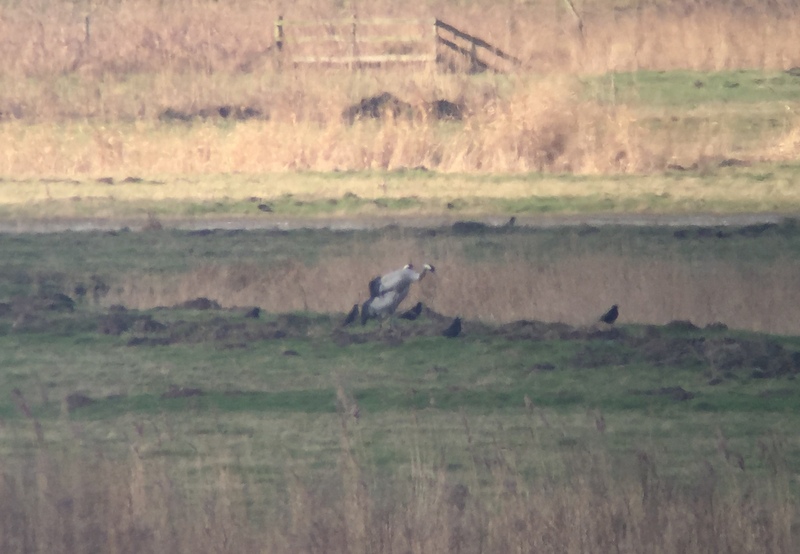 Common Crane – we found 3 pairs out on the marshes
Common Crane – we found 3 pairs out on the marshes
A short while later, one of the Crane pairs flew back in and landed again and the next thing we knew the other pair was walking towards them. They were separated by a reed lined ditch and the two males seemed to face off to each other across the ditch, they seemed to be calling but we couldn’t hear them. It is that time of the year when the pairs of Cranes are starting to re-establish their territorial boundaries ahead of the breeding season.
After watching the Cranes for a while, we made our way round to Strumpshaw Fen. We didn’t have time to explore the reserve today, but we did stop for a quick look at the pool in front of Reception Hide. The Black Swan is still in residence, and was asleep at first. When it woke up it started calling, although it was giving a strange note which confused several members of the group into thinking it was a Bittern booming at first!
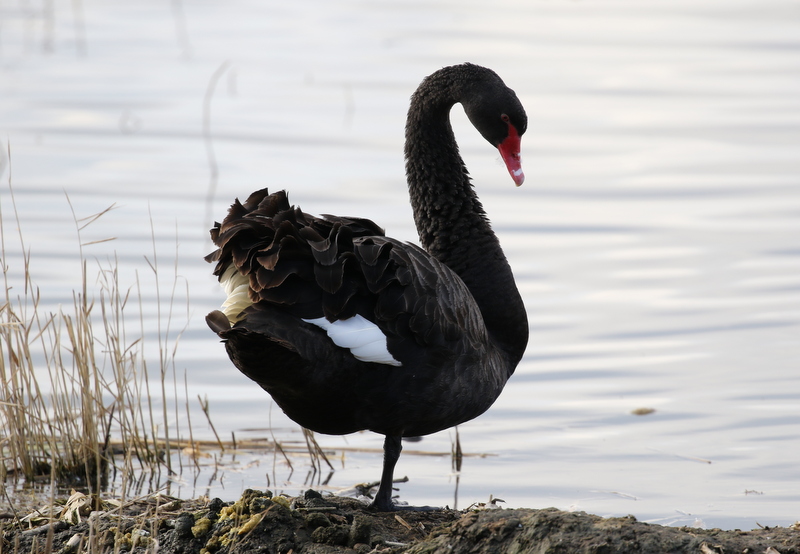 Black Swan – the feral bird still resident on the Reception Hide pool
Black Swan – the feral bird still resident on the Reception Hide pool
There were lots of Gadwall out on the pool, along with good numbers of Mallard and Coot. A single drake Shoveler was asleep on the edge of the water. Suddenly the horde of Greylags loafing around on the area of cut reed took fright and most of the ducks took off. We raced back to the viewing screen, as a shout of ‘otter’ came from inside the centre, but unfortunately it was nowhere to be seen.
 Gadwall – there were lots on the pool, until all the ducks were flushed
Gadwall – there were lots on the pool, until all the ducks were flushed
It was nice and sunny, so we had our lunch outside on the picnic tables. While we ate, we kept our eyes on the feeders nearby. A steady stream of Blue Tits and Great Tits came in to eat the seeds and eventually a Marsh Tit sneaked in too, darting in and grabbing a sunflower heart, before disappearing back into the bushes. It did this a second time but then didn’t come back again. A Coal Tit was singing from the trees nearby and a male Siskin was too. We managed to get a quick look at him, before he flew off closely followed by a female Siskin too.
After lunch, we made our way east. Most of the wild swans which have spent the winter in the Broads seem to depart in early February, but there are still some large herds of Mute Swans around. We stopped to look at one on the way and after a careful scan through we managed to find the two lingering Bewick’s Swans with them. They were noticeably much smaller and shorter necked compared to the Mute Swans. We could also see the triangular bills of the Bewick’s Swans with the squared off yellow patch at the base.
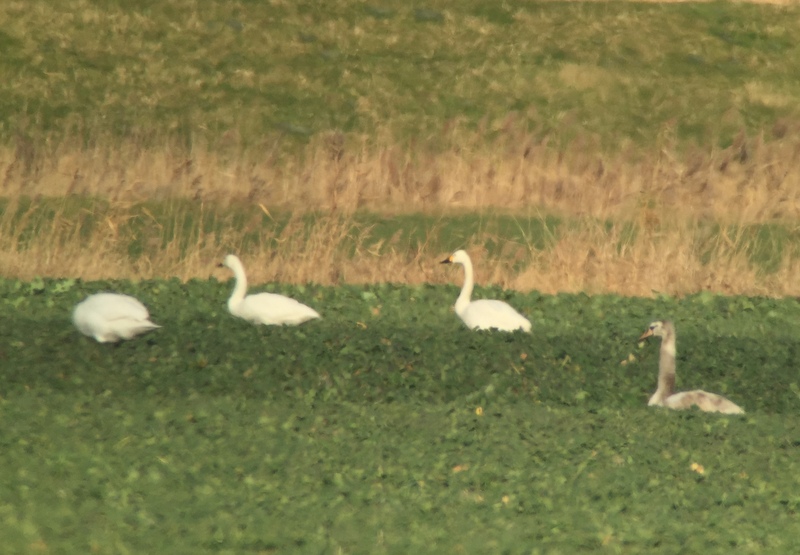 Bewick’s Swans – these two have been lingering with a herd of Mute Swans
Bewick’s Swans – these two have been lingering with a herd of Mute Swans
From here it was just a short drive round via Great Yarmouth to Burgh Castle. The impressive roman fort here provides a great location from which to scan the marshes of Haddiscoe Island. It didn’t take too long to find the Rough-legged Buzzard on one of its usual posts, aided by the fact it was being mobbed by two Short-eared Owls at the time! It was very distant at first, but after a while it took off and flew round, coming a little closer. It landed on another gatepost for a few seconds before flying back round to where it had started again. At least it flashed its distinctive mostly white tail as it flew.
Scanning the island, we found another Short-eared Owl much closer to us. We watched it quartering the grass below us, flying round on distinctive stiff wings. A fourth Short-eared Owl appeared a little further back. While we were watching the Short-eared Owls, a Barn Owl made several passes back and forth over the reeds in front of us. When one of the group spotted an owl just behind the bushes on the near side of the river, it was assumed it would be a Barn Owl, but when we all got onto it it turned out to be a Short-eared Owl. Unfortunately, it flew quickly over the hedge and disappeared inland behind the fort.
There were a few ducks and waders gathered down on the muddy edge of the river channel in front of the fort. We could see three Shelduck along with a few Wigeon and Teal. There were quite a few Redshanks roosting but two of them looked rather paler. Through the scope, we could see that they were actually Spotted Redshanks, much whiter below and more silvery grey above than the nearby darker Common Redshanks.
One of the group had asked earlier in the car about how to identify Common Gull from Black-headed Gull and, conveniently, when two gulls landed close to us on the grass of the fort we could see that there was one of each. It was a good opportunity to see them side by side, the Black-headed Gull having reddish bill and legs and the Common Gull‘s being yellowish. The Common Gull also lacked the black spot on the head of the winter Black-headed Gull and had a darker grey back and more extensive black wingtips.
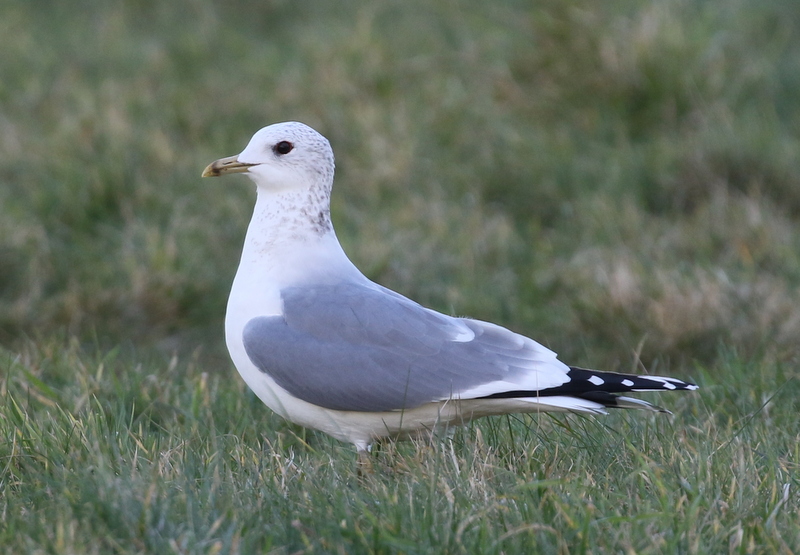 Common Gull – landed next to us with a Black-headed Gull for comparison
Common Gull – landed next to us with a Black-headed Gull for comparison
The Common Gull flew off a bit further across the grass but the Black-headed Gull remained just behind us. When we turned around to look at it again, we could see it was treading feverishly up and down on the spot. The sound of the fast footsteps is meant to resemble rain falling and bring worms and other invertebrates to the surface. It seemed to be working as the Black-headed Gull picked up several worms in the short time we were watching it doing its rain dance.
On our way back round, we stopped off on the south side of Breydon Water. There had been a large flock of Tundra Bean Geese on the grazing fields here for the last couple of days. They had not been seen this morning, but had apparently reappeared this afternoon, so we thought it was worth looking in. Unfortunately, they had already flown off again by the time we got there.
Breydon Water is a large tidal estuary and generally holds a wide selection of ducks and waders. Today was no exception, and we could see a huge throng from up on the South Wall. Scanning through the waders, there were good numbers of Avocet, Curlew, Black-tailed Godwit and Dunlin, as well as masses of Lapwing and Golden Plover. The duck included some smart looking Pintail, along with good numbers of Wigeon and Teal.
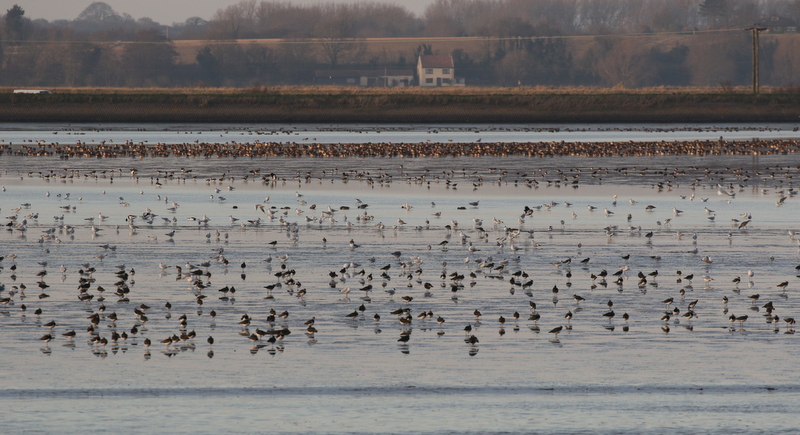 Breydon Water – huge numbers of waders, ducks and gulls gathered on the mud
Breydon Water – huge numbers of waders, ducks and gulls gathered on the mud
We were just working our way through the birds to see what was there when suddenly all the waders erupted. We couldn’t see what had flushed them, possibly one of the local Peregrines, but the air was filled with vast swarms of whirling waders. Most of them were Golden Plover and Lapwing – recent counts here have numbered about 7,000 and 8,000 of each, respectively! It was quite a sight to watch them all in the sky.
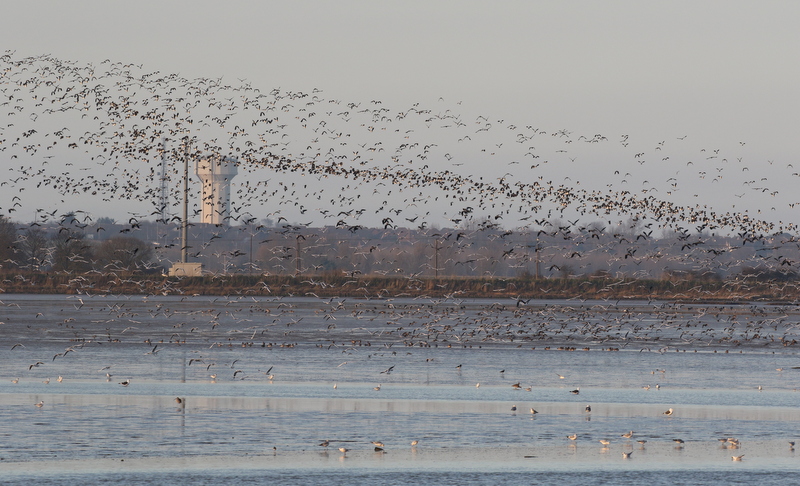
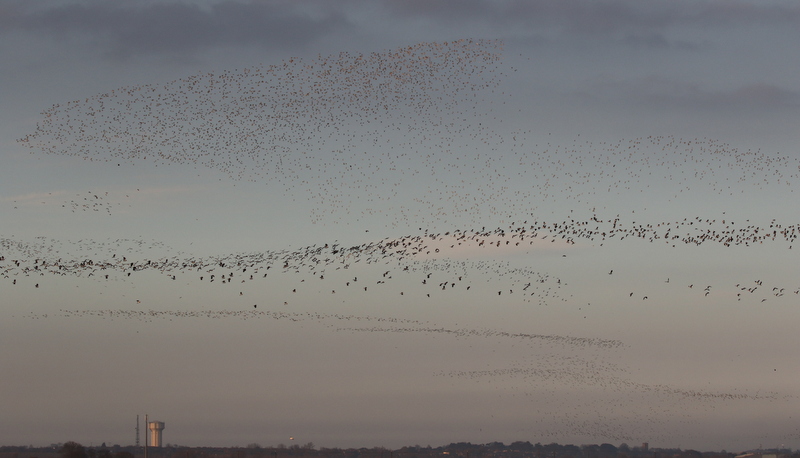
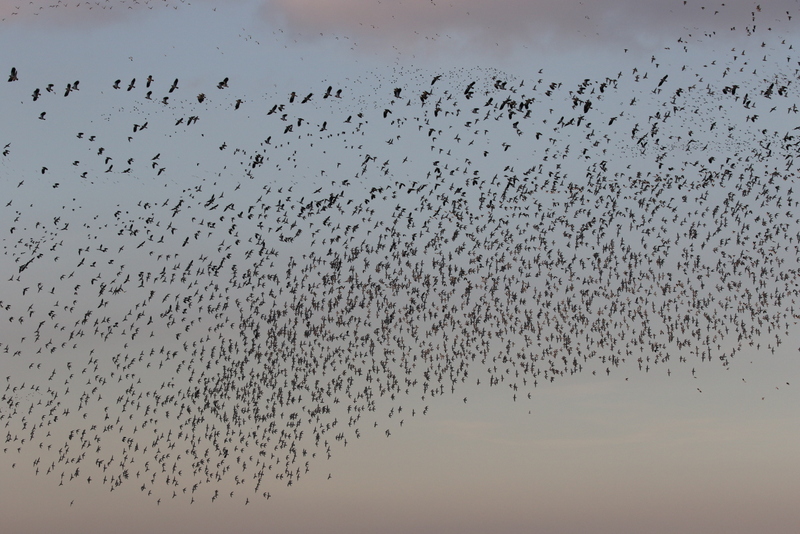
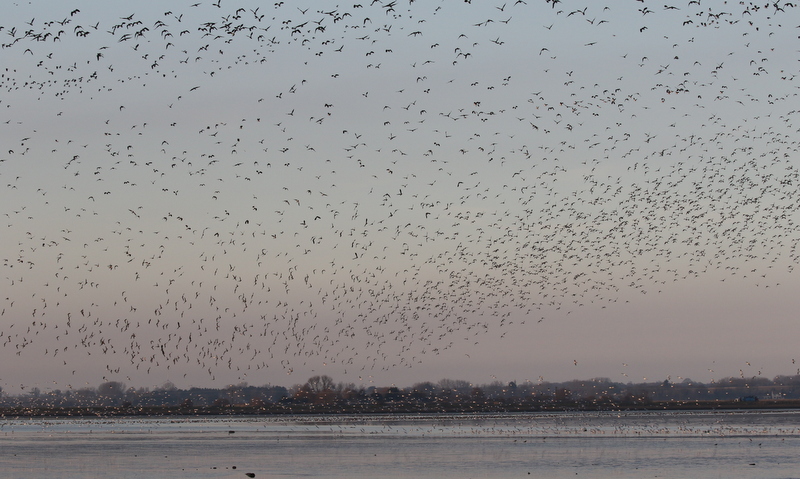 Waders – the whirling flocks over Breydon Water
Waders – the whirling flocks over Breydon Water
As is the spectacle of the whirling wader flocks was not enough, we looked through beyond them and could see a large flock of Starlings in the sky, over the grazing marshes the other side of Breydon. The flock started to disperse, then suddenly coalesced again, swirling down towards the ground to be met by another flock of Starlings coming up from the ground below. As well as the mini Wader Spectacular, we had a mini murmuration too!
The sun was already going down fast now and we were running out of time. We still wanted to have a quick look in at Stubb Mill on the way home, so we made our way quickly round there. As we were walking up to the watchpoint, we heard someone call out ‘Cranes‘ and we looked across to see two Cranes flying in over the reeds. They flew across in front of us and disappeared round behind the bushes beyond. Not long after, a second pair of Cranes did exactly the same.
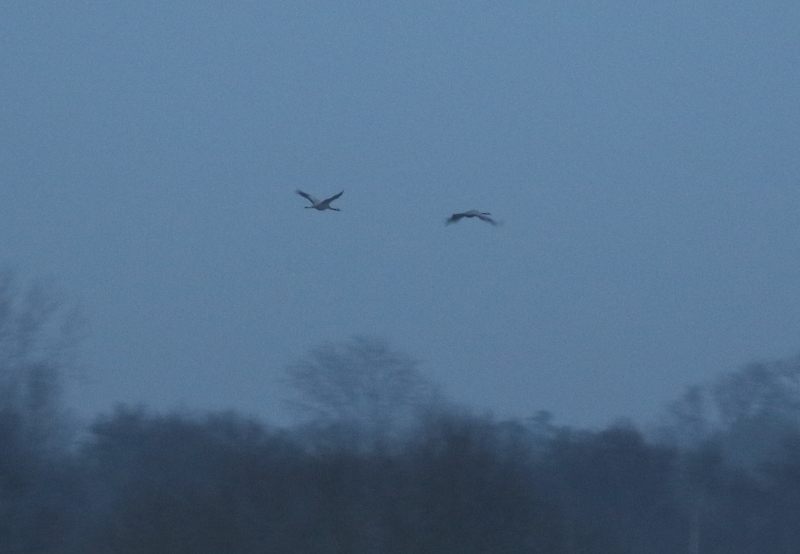 Common Crane – a pair flying in to roost in the mist at dusk
Common Crane – a pair flying in to roost in the mist at dusk
Unfortunately, some mist was starting to build over the ground when we arrived and it rapidly thickened which made it hard to see over to the raptor roost. We could see a few Marsh Harriers flying around and a few more made their way in high as we watched. However, with visibility deteriorating and the light fading, we decided to call it a day. As we drove back from the reserve towards the village, a Chinese Water Deer bounded across the road in front of us and a Barn Owl flew alongside the car, leading the way home.
















